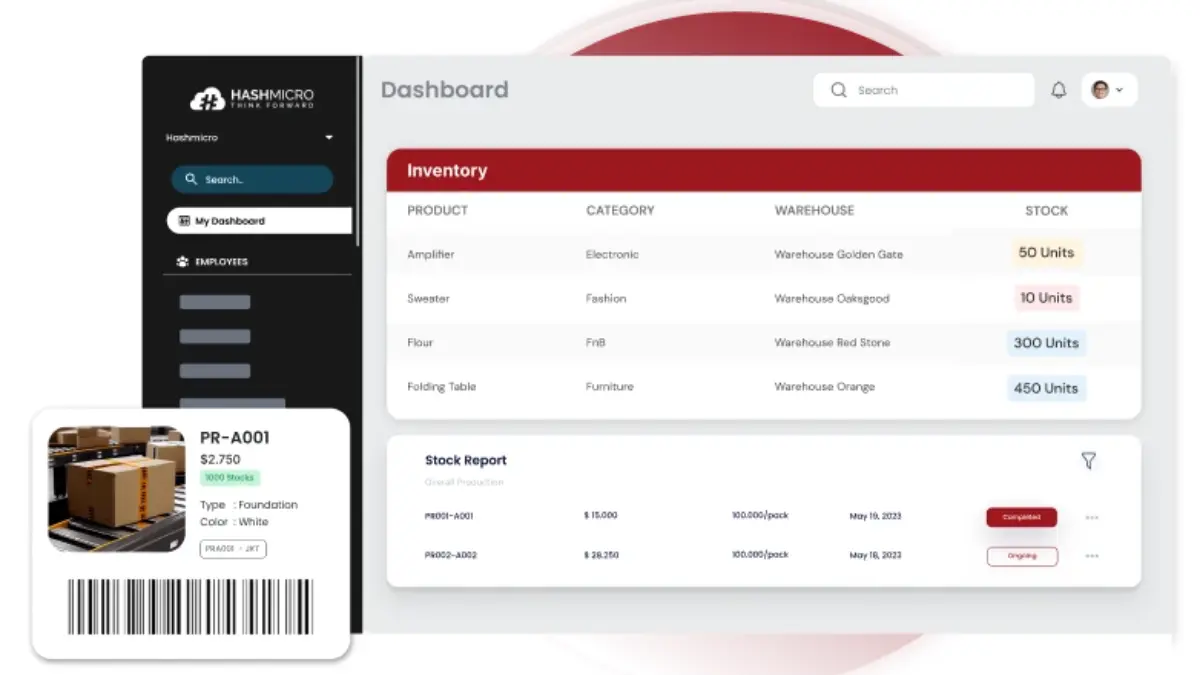Inventory reconciliation is the process of comparing physical stock with recorded data to identify discrepancies and maintain inventory accuracy. It’s an essential practice that helps us understand the root causes of stock variances and improve overall control across the supply chain.
Without proper tracking, business risk issues like stockouts or overstocking can lead to lost sales and higher storage costs. To overcome these challenges, I rely on automation tools that streamline the reconciliation process. A recent SGTech survey found that 80% of Singapore companies have adopted automation to boost productivity and address labor issues.
Now, it’s your turn to try this automation solution. Try HashMicro Inventory Management Software today and experience smarter, more efficient inventory control. Get a free demo here.

Key Takeaways
|
What is Inventory Reconciliation?
Inventory reconciliation is the act of taking inventory of everything you have and making sure your stock records match reality. It’s important to reconcile your inventory periodically to find any discrepancies that need to be addressed.
Differences in inventory often arise from recording mistakes, damaged goods, or stock losses. However, by regularly performing inventory management software, companies can maintain accurate data and prevent potential losses.
Moreover, reconciliation plays a crucial role in helping managers make well-informed decisions about stock management. This process also enhances operational efficiency by ensuring inventory is consistently and accurately monitored.
How Inventory Reconciliation Enhances Business Operations
Inventory reconciliation plays a vital role in ensuring the smooth functioning of business operations. By regularly aligning physical inventory with digital records, businesses can maintain accurate stock levels, directly impacting their ability to meet customer demand.
Moreover, consistent inventory reconciliation helps identify and address discrepancies early on, such as shrinkage due to theft, damage, or administrative errors. By catching these issues before they escalate, businesses can take corrective actions that protect their assets and improve profitability.
Ultimately, practical logistic management software boosts operational efficiency by providing reliable data for better decision-making. With accurate inventory information, businesses can optimize their purchasing, sales, and warehouse management strategies while reducing unnecessary costs and supporting sustainable growth.
7 Steps Involved in Inventory Reconciliation

Managing inventory reconciliation is critical to maintaining accurate stock levels and ensuring smooth business operations. Here are seven essential steps to guide you through the inventory control system process and help you achieve optimal results.
1. Choose your inventory reconciliation method
Choose the right reconciliation method—daily, weekly, or monthly—based on your inventory size and transaction volume to maintain accuracy and efficiency. Automating the process with HashMicro Inventory Management Software ensures smoother operations and error-free inventory control.
2. Count your physical inventory
Conduct a detailed physical count of your inventory to ensure the data reflects actual stock conditions. Accurate counts are essential for effective inventory management and preventing discrepancies.
3. Compare physical counts and digital records
After counting, compare your physical stock with digital records to identify any discrepancies. Regular checks help detect errors early and keep your inventory data accurate and up to date.
4. Identify missing items and sources of discrepancies
If discrepancies arise between physical counts and records, identify missing items and their causes, such as errors or losses. Investigating these issues helps prevent future discrepancies and improve inventory accuracy.
5. Record discrepancies and reconcile your inventory
Record any discrepancies found and update your inventory data to match actual stock levels. This ensures transparency, accuracy, and readiness for the next reconciliation cycle.
6. Take corrective action
Address the root causes of discrepancies by improving training, security, or tracking systems. These corrective actions prevent recurring issues and strengthen long-term inventory management.
7. Routinely reconcile inventory
Make inventory reconciliation a regular practice to maintain accurate records and catch discrepancies early. Consistent checks ensure smooth operations and long-term inventory accuracy.
Benefits of Performing Regular Inventory Reconciliation

Regular inventory reconciliation is more than a routine task; it’s critical to effective business management. Let’s explore the key benefits that an inventory control system can bring to your business.
1. Accurate inventory reports and data
Regular inventory reconciliation ensures that your reports accurately reflect actual stock levels. Consistent verification prevents costly mistakes, improves communication, and supports efficient operations.
2. Improved demand forecasting
Accurate inventory data enhances demand forecasting, allowing you to predict future needs and allocate resources effectively. This improves product availability, customer satisfaction, and overall profitability.
3. Mitigated shrinkage risk
Inventory shrinkage from theft, damage, or errors can significantly impact profits. Regular reconciliation helps detect issues early and implement measures to minimize losses and improve efficiency.
4. Updated safety stock levels
Maintaining accurate safety stock levels ensures a balance between supply and demand. Regular reconciliation prevents emergency orders, improves cash flow, and enhances business stability.
5. Identify theft and fraud
Regular inventory reconciliation helps detect theft and fraud by revealing suspicious discrepancies early. This proactive approach safeguards assets, minimizes losses, and promotes accountability within your organization.
3 Methods for Performing an Inventory Reconciliation

Practical inventory reconciliation is essential for maintaining accurate stock levels and ensuring smooth business operations. Below, we’ll explore three proven methods for performing inventory reconciliation that can help you maintain accuracy and efficiency.
1. Checking inventory seasonally
Seasonal inventory checks help businesses reconcile stock during peak seasons or significant sales periods. Using a cloud-based inventory system enhances this process by providing real-time insights and automating reconciliation for greater accuracy and efficiency.
2. ABC method
The ABC method classifies inventory into A, B, and C categories based on value and business impact. This approach prioritizes high-value items for frequent checks, optimizing resources and ensuring critical inventory accuracy.
3. Checking at random
Random inventory checks, or spot checks, involve unannounced counts of random items during a routine stock audit to detect hidden discrepancies. This approach maintains accuracy, keeps staff vigilant, and strengthens overall inventory control.
Inventory Reconciliation Tips

Effective inventory reconciliation is essential for maintaining accurate stock levels and ensuring smooth business operations. Implementing practical strategies can significantly reduce errors and save time, making this process as efficient as possible.
Here are some valuable tips to help you streamline your inventory reconciliation efforts and achieve better results.
- Use inventory management software: Implement inventory management software to automate tracking and reduce manual errors, ensuring accurate and up-to-date records.
- Use barcode scanners: Utilize barcode scanners to speed up counting and minimize human error, seamlessly integrating with your inventory management system.
- Organize inventory before counting: Organize your inventory by categories or locations before counting to streamline the process and ensure accurate reconciliation.
- Regularly count inventory: Conduct regular inventory counts to catch discrepancies early and maintain accurate stock levels, preventing overstock or stockouts.
- Compare your shrinkage rates after each count: Analyze shrinkage rates to identify and address any loss patterns, improving overall inventory management.
Improve Your Inventory Reconciliation with HashMicro’s Inventory Management Software

HashMicro is the leading ERP software provider in Singapore. It is trusted by businesses of all sizes across diverse industries to streamline their inventory management processes. With a proven track record, HashMicro helps companies achieve greater efficiency and accuracy in managing their inventory.
If you want to learn more about how HashMicro’s inventory management software can benefit your business, you can try a free demo with our professional team. This hands-on experience will give you a deeper understanding of the software’s capabilities and how it can be tailored to your specific needs.
Below, we will explore inventory management software comprehensive features to enhance business efficiency, such as:
- RFID Warehouse Rack Stock In-Out Automation: Automating the tracking of stock movements in and out of warehouse racks significantly enhances inventory management efficiency and accuracy. This technology ensures that every item is precisely monitored, reducing errors and saving valuable time.
- Stock Forecasting: Proactively managing stock levels through forecasting optimizes inventory and boosts customer satisfaction. By predicting demand, businesses can maintain the proper inventory levels, avoiding both shortages and excesses.
- Run Rate Reordering Rules: Establishing reorder rules based on market trends ensures the warehouse maintains adequate stock levels to meet demand without overstocking. This approach keeps your inventory balanced, preventing unnecessary costs and shortages.
- Fast Moving Slow Moving Stocks Analysis: Analyzing fast and slow-moving stock helps identify products with high and low turnover rates, enabling strategic planning like prioritizing restocks, launching sales promotions, or phasing out slow sellers. This insight allows for better resource allocation and inventory management.
- Stock Reservations & Reporting: Ensuring the availability of desired items through effective stock reservations and detailed reporting enhances inventory management efficiency. This process guarantees that critical stock is always on hand, improving operational flow and customer satisfaction.
- Quality Control Management: Establishing and managing quality standards for every product stored in the warehouse ensures that only top-quality items are processed. This involves scheduling regular quality checks, inspecting incoming and outgoing goods, and identifying defective or non-compliant products.
These features are designed to support your business’s unique requirements, ensuring that inventory management is effective and seamless.
In addition to these features, HashMicro stands out with its exceptional flexibility in customizing solutions and integrating with various modules and third-party systems. This adaptability ensures that the software can be tailored to meet the specific needs of any business, driving efficiency and success in today’s competitive market.
“Inventory reconciliation is essential for maintaining accurate stock data, minimizing discrepancies, and ensuring informed business decisions based on reliable inventory records.”
— Angela Tan, Regional Manager
Conclusion
Understanding inventory reconciliation is key to managing a company effectively. By following the steps in this article, businesses can maintain accurate inventory records, avoid costly mistakes, and improve their operations.
One of the best solutions for Inventory Reconciliation is HashMicro’s software, which offers a wide range of features designed to optimize inventory management. With its advanced automation, customizable options, and seamless integration capabilities, HashMicro provides an efficient and reliable solution for businesses of all sizes.
To experience the benefits firsthand, try a free trial system and consult with HashMicro’s professional team to find the right solution tailored to your business needs.
FAQ About Inventory Reconciliation
-
What does inventory reconciliation mean?
Inventory reconciliation refers to the practice of comparing physical stock levels with recorded data in your system. This process helps identify discrepancies and ensures that your inventory records reflect actual stock quantities across all materials.
-
How frequently should inventory reconciliation be done?
Regular reconciliation helps prevent misplaced or damaged items and ensures timely vendor payments. Ideally, businesses should perform inventory reconciliation monthly, using accurate physical counts as the baseline for verification.
-
How is inventory recorded in accounting?
Inventory transactions are tracked through specific accounting codes. Purchases are logged under an inventory object code, while sales are recorded using sales object codes. The cost of goods sold (COGS) is then transferred to the operating account to reflect the expense of sold items accurately.














